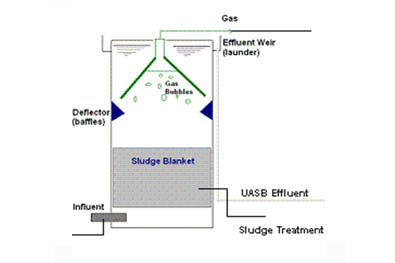UASB uses an anaerobic process whilst forming a blanket of granular sludge which suspends in the tank. Wastewater flows upwards through the blanket and is processed (degraded) by the anaerobic microorganisms. The upward flow combined with the settling action of gravity suspends the blanket with the aid of flocculants. The blanket begins to reach maturity at around 3 months. Small sludge granules begin to form whose surface area is covered in aggregations of bacteria. In the absence of any support matrix, the flow conditions creates a selective environment in which only those microorganisms, capable of attaching to each other, survive and proliferate. Eventually the aggregates form into dense compact biofilms referred to as "granules".
Biogas with a high concentration of methane is produced as a by-product, and this may be captured and used as an energy source, to generate electricity for export and to cover its own running power. The technology needs constant monitoring when put into use to ensure that the sludge blanket is maintained, and not washed out (thereby losing the effect). The heat produced as a by-product of electricity generation can be reused to heat the digestion tanks.
Benefits :
- Lowest power consumption as no air blowers are required unlike in aerobic systems
- Lowest sludge generation
- Methane can be used as bio-gas
- Lowest maintenance and running cost
- Very low foot print area required

